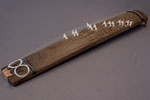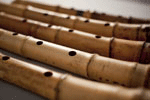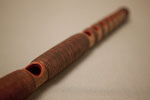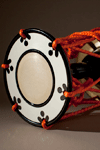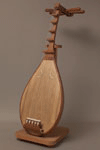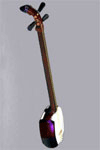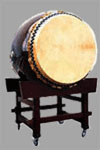
SHAKUHACHI
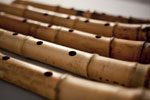
The shakuhachi is a type of vertical bamboo flute which takes its name from its standard length of one shaku eight sun, literally 1.8 Japanese feet (approx. 55cm). In China there is a vertical flute, dosho/dongxiao. A shakuhachi with 6 holes used in gagaku, Japanese imperial court music in ancient times is thought to have descended from this, but has now disappeared.
The shakuhachi of today originated in the modern era (Edo period) from a 5 hole fuke shakuhachi which was used as a spiritual tool by komusō, wandering Buddhist priests of the Fuke sect. Unlike the recorder, the shakuhachi has no mechanism to control the flow of air through the embouchure and thus requires accurate angle and lip shape in order to produce a sound. Based on the number of finger wholes, it would expected to produce only a pentatonic scale, however, through the use of various fingerings, half holing and by adapting the angle of the embouchure on the lips, a wide range of tones can be produced including a howling effect.
In the Edo period, only the ascetic or spiritual solos known as honkyoku where officially recognised. However, since Meiji, ensembles known as 'three instruments ensembles,' with koto and shamisen, have also become popular. Aside from the standard one shaku eight sun (approx. 55cm), shakuhachi come in a variety of lengths with one sun in length changing the pitch half a tone.
Music Library
- Echigo San-ya
- Composer UNK*
- Year UNK*
- play
- Classic honkyoku. In the Edo period, shakuhachi were played by disciplinants called komusō who had temple bases all around the country. This is a difficult piece that spread to Echigo's (present day Niigata Prefecture) Myōan temple and makes the best of a particular way of playing. Played on a shakuhachi, two shaku four sun in length, that is a perfect fourth lower than the standard.
- Shika no Tōne
(Deer calling at a distance) - Composer UNK*
- Year UNK*
- play
- Kinko school honkyoku. A distinguished masterpiece even amongst classic shakuhachi honkyoku (traditional solos). Originally a duet depicting two deer calling to one and other, but in this performance is played as a solo.
- Gekko Routeki
- Rando Fukuda
(1905-1976) - 1933
- play
- Composer is known both for the radio drama "Fuefuki Douji" ("Flute-playing Child") composition and also as a shakuhachi player. This piece evokes the image of improvised playing while gazing at the moon.
- Kakurin
(Wood of the Crane) - Ryōhei Hirose
(1930-2008) - 1973
- play
- The composer, together with Makoto Moroi, Tōru Takemitsu, left behind a piece for traditional Japanese musical instruments using contemporary techniques. This piece consisting of 6 movements, adopts innovative ways of playing such as the discretionary fragmentation of melodic figure. The title, refers to Buddha's entrance to Nirvana.
* Composer UNK:Name of composer unknown. Year UNK:Year of composition unknown.
Performance by Kenji Yamaguchi
In each episode, when staff notation is applicable, it is standardized by absolute pitch notation.
























